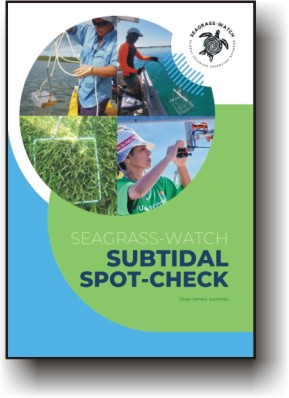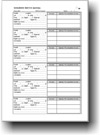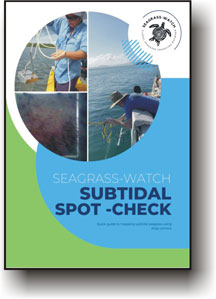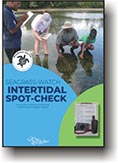Subtidal & intertidal spot-check resources
MENU
The fundamental objective of a field survey is to identify seagrass occurrence from other benthos and, if possible, document seagrass state and determine the meadow edges/boundaries.
Field surveys are also essential when the mapping approach includes high-earth or spaceborne image capture (e.g. drone, airplane or satellite) to evaluate image signatures, examine areas where the imagery does not provide information (e.g., optically complex waters such as in areas of heavy turbidity), and to provide validation data for accuracy assessments.
Seagrass state can be determined by measuring a number of essential variables (seagrass percent cover and species composition) and supporting variables (e.g. sediment, water depth, water clarity / turbidity).
Field surveys can be executed using a range of methods which can be conducted by foot or from a vessel (e.g. boat, drone, helicopter).
Methods can include walking, diving (free or SCUBA), benthic grabs or sleds. The type of method is dependent on the type of environment.
Subtidal/Intertidal spot-check
Spot-checks are where the field validation is conducted at a specific point in the Area Of Interest and observations of benthic variables are measured in situ or post hoc.
The point can be predetermined in the planning phase of the survey strategy or ad hoc (when necessary or needed). The size (radius) of the point where the spot-check is conducted is generally the positional accuracy of the geolocation device (e.g. 1-3m).
Field measures can be collected using photoquadrats, quadrat observations or sampler observations. Spot-checks can be conducted: in person by foot, diving (free or SCUBA), or drone; remotely using drop camera, ROV; or via a sampler, such as a grab, rake, sled.
Although only one observation (sample) is necessary at a spot-check, it is recommended to take replicate samples spread within the point (e.g. 3 observations) to ensure the variation of point characteristics are well represented. This can be done by haphazardly dropping/lowering subtidal drop camera within an area of an approximate 1-3 metre radius around you, and recording the quadrat measures each time.
Subtidal spot-check using a Drop Camera
A number of designated points are selected within an area to map subtidal seagrass. To account for spatial heterogeneity, 3 drops are conducted at each point. A subtidal point is defined as an area of 5m radius.
Methodology: At each point, a GoPro® drop-camera assembly (incl. frame with 0.25m2 quadrat in field of view) is used to visually assess the seabed and the footage recorded for post-field analysis.
Subtidal spot-check demonstration video
Please note: This video is only intended for demonstration purposes. For more detailed information and consultation, please contact Seagrass-Watch HQ
Subtidal Instructional Videos
Choose the video guide that corresponds to your seagrass field assessment activity
Drop-cam and Frame set up
STEP 1: MATERIALS TO SET UP A DROP CAM KIT
Video detailing what is needed to set up a drop-camera kit
STEP 2: HOW TO ASSEMBLE A COLLAPSIBLE FRAME
Video detailing how to assemble a collapsible frame.
Thanks to Marine Research Foundation (www.mrf-asia.org) for assistance with imagery and instructions
STEP 3: HOW TO LINK SMART DEVICES WITH GoPro
Video detailing how to set up link between GoPro and Smart device
STEP 4: HOW TO ASSEMBLE DROP-CAMERA
Video detailing how to assemble a drop-camera frame using GoPro
subtidal spot-checks
STEP 5: HOW TO CONDUCT SUBTIDAL SPOT-CHECKS
Video detailing how to conduct subtidal spot-checks using drop-camera
STEP 6: HOW TO AVOID BAD DROPS
Video detailing how to get the best out of your subtidal spot-checks
STEP 7: HOW TO USE A VAN VEEN GRAB
Video detailing how to use a Van Veen Grab.
Using the Van Veen Grab at each mapping point will assist with verifying seagrass presence and enable visual/tactile assessment for sediment description. NB: You may need to do several grabs to verify and samples do not need to be retained.
Intertidal spot-checks & photo transects
If the mapping approach is field-based, then the simplest procedure is to conduct field mapping using spot-checks and boundary tracking.
Depending on the size of the AOI, spot-checks can be conducted in a grid pattern or along lines perpendicular to shore, with haphazard points in-between.
When mapping a region of relatively homogenous coastline between 10 and 100 km long, it is recommended that survey lines should be no further than 500-1000 m apart from each other. For regions between 1 and 10 km, it is recommended survey lines be approximately 100-500 m apart and for localities less than 1 km, it is recommended 50-100 m apart.
This however may vary depending on the complexity of the regional coastline, i.e., more complex, then more lines required. Survey lines generally follow a compass bearing and distances can be estimated, rather than accurately determined using a tape measure
Although only one observation (sample) is necessary at a spot-check, it is recommended to take replicate samples spread within the point (e.g. 3 observations) to ensure the variation of point characteristics are well represented. This can be done by haphazardly tossing a quadrat within an area of an approximate 1-3 metre radius around you, and recording the quadrat measures each time.
Photo transects
Field observations are collected using photoquadrats (still or video) conducted in person (by foot, diving – free or SCUBA) or remotely using an underwater drone or towed video sled. Measures of seagrass and benthic variables are conducted post hoc by a scientist or using machine/deep learning.
Each photoquadrat captures a 1m2 area of the benthos, every 2-3 meters along 100+m long transects positioned in transitional zones to capture the full range of benthic types (e.g. bare substrate to sparse seagrass to dense seagrass to algae to reef).
Photo-transect locations are chosen based on expert interpretation of high or spaceborne imagery to determine best placement to ensure coverage of the variety of benthic cover types to provide the most benefit for the mapping calibration / validation. The direction and length of the transects ensure that the photos capture the variance in the benthic composition.
Transects are often perpendicular to the perceived meadow boundary. The transect locations are generally pre-planned on available imagery as waypoints of either end of the transect that can be uploaded to a handheld GPS unit for the field.
Photo-transects can be conducted by foot when the area to be surveyed is exposed during low spring tides, or the water is very shallow (<0.5m depth), sea state smooth and water clear.
Intertidal spot-check demonstration video
Please note: This video is only intended for demonstration purposes. For more detailed information and consultation, please contact Seagrass-Watch HQ
Intertidal spot-check Instructional Videos
Choose the video guide that corresponds to your seagrass field assessment activity
HOW TO CONDUCT INTERTIDAL SPOT-CHECK
Video detailing how conduct intertidal spot-checks
HOW TO CONDUCT PHOTO TRANSECTS
Video detailing how conduct photo transects



